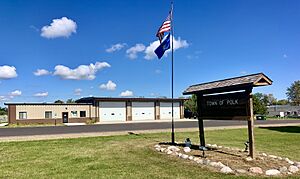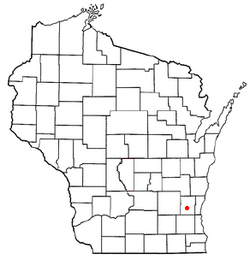Polk, Wisconsin facts for kids
Quick facts for kids
Polk, Wisconsin
|
|
|---|---|

Town hall
|
|

Location of Polk, Wisconsin
|
|
| Country | |
| State | |
| County | Washington |
| Incorporated | January 21, 1846 |
| Area | |
| • Total | 32.2 sq mi (83.4 km2) |
| • Land | 31.9 sq mi (82.7 km2) |
| • Water | 0.3 sq mi (0.7 km2) |
| Elevation | 1,122 ft (342 m) |
| Population
(2000)
|
|
| • Total | 3,938 |
| • Density | 123.3/sq mi (47.6/km2) |
| Time zone | UTC-6 (Central (CST)) |
| • Summer (DST) | UTC-5 (CDT) |
| Area code(s) | 262 |
| FIPS code | 55-63875 |
| GNIS feature ID | 1583950 |
Polk is a town in Washington County, Wisconsin, in the United States. In 2000, about 3,938 people lived there. Several small communities are part of the town, including Ackerville, Cedar Creek, Cedar Lake, Diefenbach Corners, Mayfield, and Rugby Junction. The town was named after James K. Polk, who was the 11th President of the U.S. when the town officially started in 1846.
Contents
History of Polk
Early Native American Life
In the early 1800s, the land that is now Polk was home to the Potawatomi Native Americans. In 1833, they gave up their land to the United States government through a special agreement called the 1833 Treaty of Chicago. This treaty meant they had to leave Wisconsin by 1838.
Many Potawatomi people moved west to Kansas. However, some chose to stay in Wisconsin. They were sometimes called "strolling Potawatomi" because they moved around. They lived on their old lands, which were now owned by new settlers.
One group of Potawatomi traveled through nearby counties. Their leader was Chief Kewaskum. He had a camp near Pike Lake, west of the Polk area. Chief Kewaskum was friendly with the white settlers who started arriving in the 1840s. He died sometime between 1847 and 1850. The nearby Village of Kewaskum was named in his honor. Some Potawatomi continued to live in Washington County until the late 1800s. Many of them later joined the Forest County Potawatomi Community in northern Wisconsin.
First Settlers and Town Creation
In 1843, William Williamson bought land and became the first white settler in the area. Another early settler was Densmore Maxon, who arrived in 1844. He bought land along Cedar Creek and built one of the first sawmills. Maxon became an important leader in the early community.
In 1845, Baruch Schleisinger Weil arrived. He bought almost 2,000 acres of land. He also built a general store to provide supplies for the new settlers. The Town of Polk was officially started on January 21, 1846. It was named after James K. Polk, who was the U.S. President at that time.
The Railroad and Growth
In 1855, Mr. Weil helped bring the La Crosse and Milwaukee Railroad through Polk. A large train station was built on his land in Schleisingerville. This place is known today as Slinger. The train also stopped at a station in the small community of Ackerville.
The railroad first helped the local economy grow. But the railroad company later had problems in 1861. Many landowners had borrowed money for the railroad in exchange for company shares. When the company failed, these landowners still had to pay back their loans. This caused problems for many families, and some had to sell their farms.
In 1863, another company bought the railroad and started running it again. Schleisingerville continued to grow. In 1869, it became its own village, taking some land from the Town of Polk.
Polk in Recent Times
In the 1900s and 2000s, nearby villages like Jackson, Richfield, and Slinger grew larger. They took some land from the Town of Polk as they expanded. Even though it lost some land, the population of the Town of Polk has more than doubled since 1960.
Geography of Polk
The Town of Polk covers a total area of about 32.2 square miles (83.4 square kilometers). Most of this area, about 31.9 square miles (82.7 square kilometers), is land. The rest, about 0.3 square miles (0.7 square kilometers), is water.
People in Polk
Population in 2000
According to the census in 2000, there were 3,938 people living in the Town of Polk. There were 1,352 households, which are groups of people living together in one home. Out of these, 1,139 were families.
The population density was about 123.3 people for every square mile (47.6 people per square kilometer). There were 1,430 housing units, like houses or apartments.
Diversity and Age
Most of the people in Polk were White (98.70%). A small number were African American (0.20%), Native American (0.15%), or Asian (0.15%). About 0.91% of the population were Hispanic or Latino.
About 38.3% of households had children under 18 living with them. Most households (77.2%) were married couples living together.
The population was spread out by age:
- 26.9% were under 18 years old.
- 6.7% were between 18 and 24 years old.
- 28.5% were between 25 and 44 years old.
- 27.5% were between 45 and 64 years old.
- 10.4% were 65 years or older.
The average age of people in Polk was 39 years.
Income and Economy
In 2000, the average income for a household in Polk was $62,933 per year. For families, the average income was $74,643 per year.
The average income per person in the town was $27,518. About 3.5% of all people in Polk lived below the poverty line. This included 2.2% of those under 18 and 7.9% of those 65 or older.
Notable People
- Valentine Detling, a Wisconsin businessman and lawmaker, lived in Polk.
- Louis D. Guth, a Wisconsin businessman and lawmaker, was born in Polk.
- James Rolfe, a Wisconsin farmer and lawmaker, lived in Polk.
See also
 In Spanish: Polk (Wisconsin) para niños
In Spanish: Polk (Wisconsin) para niños

